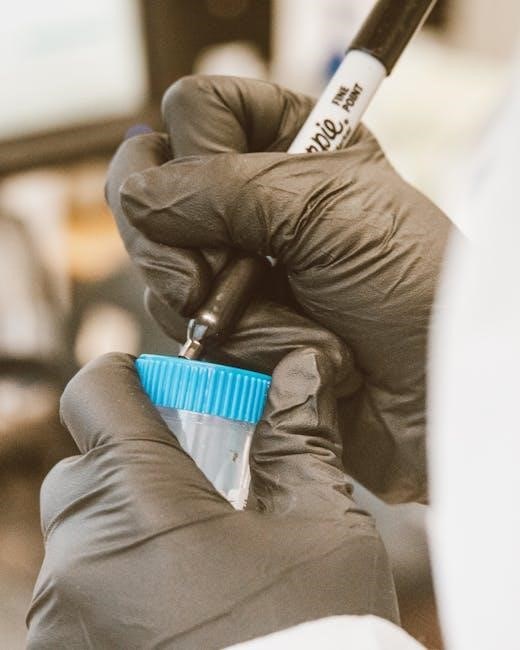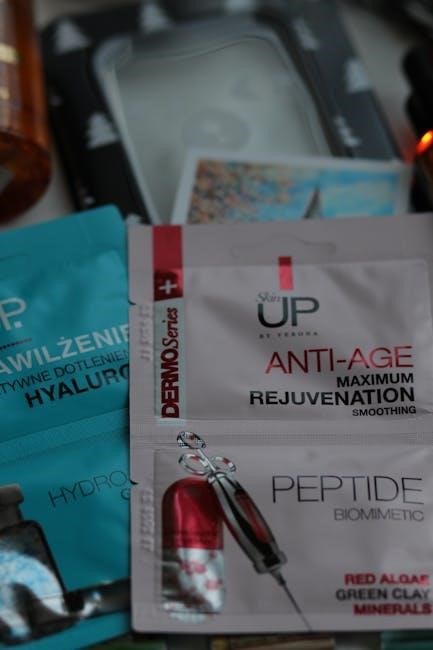Peptide protocols are standardized methods guiding the use of peptides in research and therapy. They ensure safety, efficacy, and reproducibility, making them essential in medical and scientific applications.
1.1 Overview of Peptide Protocols

Peptide protocols are systematic guides outlining the synthesis, analysis, and application of peptides in research and therapeutic settings. They provide detailed instructions for handling peptides, ensuring consistency and accuracy in experiments. These protocols cover various aspects, including peptide synthesis methods, purification techniques, and bioassays. They are widely used in immunology, proteomics, and regenerative medicine. JPT Peptide Technologies offers comprehensive PDF protocols for researchers, while Dr. William A. Seeds’ work emphasizes their therapeutic potential. Peptide protocols are essential for advancing peptide science, ensuring safety, and optimizing outcomes in both laboratory and clinical environments.
1.2 Importance of Peptide Protocols in Research and Therapy
Peptide protocols play a pivotal role in advancing research and therapeutic applications by ensuring reproducibility, safety, and efficacy. They provide standardized methods for peptide synthesis, purification, and administration, which are critical for achieving accurate and reliable results. In therapy, these protocols guide clinicians in optimizing peptide-based treatments, reducing risks, and enhancing patient outcomes. Their importance extends to regenerative medicine and anti-aging, where peptides are used to delay senescence and reduce inflammation. By adhering to established protocols, researchers and practitioners can unlock the full potential of peptides, driving innovation and improving healthcare outcomes across various fields.

Understanding Peptides and Their Structure
Peptides are short chains of amino acids linked by peptide bonds, varying in length from dipeptides to polypeptides. Their structure determines function and bioactivity in cells.
2.1 Basic Definition and Classification of Peptides
Peptides are chains of amino acids connected by peptide bonds, ranging from two (dipeptides) to hundreds of residues. They are classified as oligopeptides (2-20 amino acids) and polypeptides (20+ amino acids). Their classification is based on size, structure, and function, with specific sequences determining biological activity. This categorization aids in understanding their roles in cellular processes and therapeutic applications, as detailed in peptide protocols.
2.2 Peptide Bonds and Chain Length
A peptide bond is a covalent linkage formed between the carboxyl group of one amino acid and the amino group of another, creating a chain. The length of the peptide chain, ranging from dipeptides (two residues) to polypeptides (20+ residues), significantly influences its function. Shorter peptides often act as signaling molecules, while longer chains fold into complex structures, resembling proteins. The number of peptide bonds determines the chain’s stability and biological activity, making chain length a critical factor in peptide design and application, as outlined in peptide protocols.
2;3 Differences Between Peptides and Proteins
Peptides and proteins differ primarily in size and complexity. Peptides are shorter chains of amino acids, typically containing fewer than 50 residues, while proteins are longer and more complex, consisting of one or more polypeptide chains. Proteins often have specialized functions and structures, such as enzymes or antibodies, whereas peptides may act as signaling molecules or have specific therapeutic roles. The distinction lies in both chain length and functional scope, as detailed in peptide protocols, which guide their use in research and medical applications.
Dr; William A. Seeds and His Contributions

Dr. William A. Seeds is a leading authority in peptide therapy, renowned for his groundbreaking work and the publication of Peptide Protocols, a comprehensive guide to peptide mechanisms and applications.
3.1 Biography and Expertise in Peptide Therapy
Dr. William A. Seeds is a distinguished medical practitioner with extensive expertise in peptide therapy and regenerative medicine. His journey in the medical field began with a strong academic foundation, leading to his MD degree. Over the years, Dr. Seeds has become a pioneer in the therapeutic applications of peptides, establishing himself as a leading authority in this innovative field. His work focuses on understanding peptide mechanisms and their potential to address various health challenges, from aging to chronic diseases. This expertise culminated in the creation of Peptide Protocols, a seminal resource for both researchers and practitioners.

3.2 Key Concepts from “Peptide Protocols” Book

Peptide Protocols by Dr. William A. Seeds is a groundbreaking handbook that introduces the cellular biology behind peptides. It explains their mechanisms of action and provides evidence-based protocols for their use in delaying cellular senescence, reducing inflammation, and preventing disease. The book is designed for physicians and researchers, offering a comprehensive guide to peptide therapy. It covers anti-aging, regenerative medicine, and therapeutic applications, making it an essential resource for understanding how peptides can address various health challenges. This first-in-series volume is a foundational text for anyone exploring the potential of peptides in modern medicine.

Applications of Peptide Protocols
Peptide protocols are applied in therapy, anti-aging, athletic performance, and wellness. They improve health outcomes, enhance physical recovery, and support regenerative processes, offering tailored solutions for diverse needs.

4.1 Therapeutic Uses of Peptides
Peptides are widely used in therapeutic settings to address various health conditions. They can reduce inflammation, improve immune function, and promote tissue repair. For instance, certain peptides like BPC-157 are known for their healing properties, while others such as GHK-Cu are used in anti-aging treatments. These compounds are often prescribed off-label, under specific protocols, to target conditions like chronic pain, inflammatory diseases, and even certain neurological disorders. Their ability to target specific cellular mechanisms makes them valuable in personalized medicine, offering precise and effective treatment options with minimal side effects compared to traditional drugs.
4.2 Peptides in Anti-Aging and Regenerative Medicine
Peptides play a pivotal role in anti-aging and regenerative medicine by targeting cellular processes that decline with age. Certain peptides, such as GHK-Cu, are known to enhance skin health by stimulating collagen production and improving elasticity. Others, like Ipamorelin, support growth hormone secretion, which can combat age-related issues like muscle atrophy and fat accumulation. These compounds also promote tissue repair and regeneration, reducing oxidative stress and inflammation. By addressing cellular senescence and improving organ function, peptides offer a natural and effective approach to reversing age-related changes and enhancing overall wellness.
4.3 Peptides in Athletic Performance and Wellness
Peptides are increasingly utilized in sports medicine to enhance athletic performance and overall wellness. BPC-157, for instance, is known for its ability to accelerate muscle repair and reduce inflammation. CJC-1295 stimulates growth hormone secretion, promoting muscle growth and recovery. IGF-1 LR3 supports lean muscle development and enhances endurance. Additionally, peptides like Melanotan II are used for tanning, which can improve appearance for athletes. These compounds are often prescribed in specific protocols to optimize benefits while minimizing side effects. By addressing recovery, muscle synthesis, and body composition, peptides provide athletes with a scientific edge in achieving peak performance and maintaining health.
Research and Development in Peptide Science
Advanced peptide protocols in mass spectrometry and proteomics drive innovation in peptide research. These methods enable precise analysis and quantification, advancing therapeutic and diagnostic applications in peptide science.
5.1 Advanced Peptide Protocols for Mass Spectrometry
Advanced peptide protocols for mass spectrometry are essential for precise peptide analysis. These protocols optimize sample preparation, ionization, and data acquisition, ensuring high sensitivity and reproducibility. Designed for proteomics research, they enable the identification and quantification of peptides in complex biological samples. JPT Peptide Technologies provides detailed PDF guides for mass spectrometry workflows, covering enzymatic digestion, peptide extraction, and chromatographic separation. These protocols are crucial for therapeutic peptide development and biomarker discovery. By standardizing methods, researchers achieve consistent results, accelerating advancements in peptide science and its applications in medicine and diagnostics.

5.2 Quantitative Analysis and Protease Studies
Quantitative analysis and protease studies are critical in peptide research, ensuring precise measurement and understanding of peptide degradation. These protocols employ advanced techniques like mass spectrometry and enzyme-linked immunosorbent assay (ELISA) to quantify peptide concentrations and assess protease activity. Protease studies reveal how enzymes affect peptide stability, aiding in the design of therapeutically stable molecules. JPT provides detailed PDF guides for these analyses, enabling researchers to optimize peptide synthesis and degradation assessments. Such studies are vital for therapeutic peptide development, ensuring efficacy and safety in clinical applications. They also enhance understanding of peptide metabolism, advancing personalized medicine and treatment strategies.

Safety and Legal Considerations
Safety and legal considerations are paramount in peptide protocols, ensuring compliance with FDA regulations and ethical standards. Proper administration and off-label use guidelines must be followed to minimize risks and ensure therapeutic efficacy. Researchers and practitioners must adhere to established safety protocols to avoid adverse effects and legal repercussions, maintaining transparency and accountability in peptide therapy applications.
6.1 FDA Approval and Off-Label Use of Peptides
Peptides are regulated by the FDA, with approvals limited to specific therapeutic uses. Many peptides, however, are prescribed off-label for anti-aging, wellness, and athletic performance. While FDA-approved peptides are rigorously tested for safety and efficacy, off-label use requires careful consideration of risks and benefits. Physicians must ensure informed consent and adherence to established safety protocols. Compliance with legal and ethical standards is crucial to avoid misuse and potential legal consequences. The balance between innovation and regulation ensures peptides remain a viable option for diverse medical applications while protecting patient safety and public health.
6.2 Safety Protocols for Peptide Administration
Safety protocols for peptide administration are critical to minimize risks and ensure efficacy. Proper dosing, sterile injection techniques, and adherence to storage guidelines are essential. Peptides must be reconstituted and administered according to specific instructions to maintain potency and safety. Patients should be monitored for adverse reactions, and medical professionals must provide clear guidance on usage. Proper disposal of needles and vials is mandatory to prevent contamination. Regular follow-ups and patient education further enhance safety outcomes, ensuring peptides are used responsibly and effectively in therapeutic and wellness applications.
Peptide protocols offer a comprehensive guide to understanding and applying peptides in medicine, providing foundational knowledge for researchers and clinicians to advance therapeutic and wellness applications effectively.
7.1 Future Directions in Peptide Research and Therapy
Future peptide research will focus on advancing personalized medicine, developing novel delivery systems, and exploring AI-driven peptide design. Therapeutic applications will expand, targeting chronic diseases and regenerative processes. Regulatory frameworks will evolve to ensure safety and efficacy, while off-label uses will require stricter oversight. Collaborative efforts between researchers and clinicians will accelerate translating peptide science into clinical practice, fostering innovation and addressing unmet medical needs. The integration of peptides in wellness and anti-aging will grow, alongside advancements in mass spectrometry and proteomics, paving the way for a new era of peptide-based solutions.